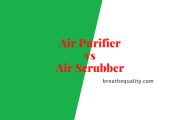You are using an air purifier to purify and give back fresh air, but you are also wondering if an air purifier is effective at removing the dust from the air. In fact, an air purifier is the most important device that can make sure your home’s air quality is almost dust-free. Without the dust in the air, you will breathe fresh air and live a much healthier and more comfortable life. Together with Breathe Quality, you have a quick answer to “Do air purifiers remove dust?”
However, this quick answer is only for those who are in a hurry. If you want to fully understand how an air purifier works to remove dust from the air, just keep reading. We all know that dust is truly an everyday problem for many of us and an unfortunate fact of life. That’s why we do everything possible to help you realize the importance of an air purifier in the mission of removing dust from the air. Also, we will give you a pocket list of the best air purifiers at an affordable price so you can, finally, live in a home without lots of dust issues.
Related posts: Best air purifiers for dust.
While, in reality, we will never be completely in a dust-free environment, there are many ways to help combat and reduce the high amount of dust in your indoor air. One of the most effective ways to reduce household dust is by using an air purifier. So, if you’re ready, we’ll see if air purifiers are the final solution to your dust problems.
Note: If you need answers to common questions about air purifiers, please read our air purifier FAQs.
Related posts
Do air purifiers remove dust?
Yes, most air purifiers are designed to remove dust from the air. Many air purifiers feature the True HEPA filter, which is a method of capturing most pollutants (including dust). A True HEPA filter is rated to capture small dust particles as small as 0.3 microns in size with 99.97% efficiency. The 0.3-micron size was the most difficult to trap and the easiest to draw into lungs.
All of these tiny particles in dust can move around your home environment by floating in the air until they settle on a convenient surface (like carpets, beds, or your room’s corners). Using an air purifier in a room will trap these particles before they have the chance to settle. The air purifier not only makes the air more pleasant to breathe but also reduces the accumulation of dust on our carpets, books, and shelves. Such convenient!
An air purifier will circulate the air in a room, and as it inhales the air, it also pulls in all of the tiny particulate matters floating in it, including dust. The air passes through the filter with ease, but the particles become trapped in the fibers. These particles that become trapped are the ones that would have turned into dust on your home surfaces or caused allergy or asthma symptoms when they were inhaled. Although an air purifier cannot remove dust particles completely, with regular use it can provide a significant reduction in household dust.
Below are some lists of the best air purifiers, with specialized purposes for use.
List of the best air purifiers
- 1, Best Air Purifiers (Air Purifier Ranking List)
- 2, Best Air Purifiers for Allergies and Asthma
- 3, Best Air Purifiers for Bedroom
- 4, Best Air Purifiers for Baby
- 5, Best Air Purifiers for Smoke
- 6, Best Air Purifiers for Dust
- 7, Best Air Purifiers for Mold
- 8, Best Large Room Air Purifiers
- 9, Best Air Purifiers for Pets
- 10, Best Air Purifiers for Office
What is Dust Made of?
Dust is an everyday problem for many of us and an unfortunate fact of life. No matter where you live, dust will accumulate and settle on all of the surfaces in your home, from your living room to your bedroom, inside and outside your home. It’s not just a nuisance; it can also be potentially hazardous to your health. Therefore, you need an air purifier as a solution to combat dust.
Although it will often look like uniform gray dirt or dead skin cells when it settles on surfaces, the dust actually contains a wide range of particles and elements shed from a surprising number of sources. For example:
- Soil that is tracked into the home
- Particulate matter from outside air
- Organic material
The organic material can be varied between plants and animals and includes:
- Skin particles
- Food debris
- Home construction materials
- Pollen
- Mold
- Pet dander
- Insect body parts
- Dust mite allergens
- Plant materials
- Hair fibers
These microscopic dust particulates are not only a cleaning issue, but they can also harm your respiratory system. They can cause allergies, sickness, and even cancer. Without good methods to reduce dust, you will constantly breathe in more and more of this dangerously tiny thing.
Why you need to remove dust?
First, no one can deal with dust. It is totally dirty when looking at our cabinets, table tops, and shelves coated with dust.
It may be easy to clean up the dust that stacks under the couch, the bed, or the shelves, but the dust that suspends in the air is another story. If you are able to remove dust from surfaces and carpets, that will help your home a lot. But it is inevitable that your home will always face the most irritating dust particles floating in the air. Dust often includes a diversity of debris, contaminants, and allergens (viruses) that can be unhealthy to breathe in. If you or a family member is too sensitive to dust, you should find the right air purifier for dust removal to help.
Also, it is a tedious chore to clean your house every day. Additionally, the moment you leave your home or room, this disaster named “dust” continues. We should conclude that dust seems to be a never-ending problem. Cleaning and providing ventilation to deal with symptoms of dust can resolve them once, but not permanently.
Dust is harmful to your respiratory health. Because most Americans spend up to 90% of their day indoors, it’s an urgent task to reduce dust in indoor air. Your lungs are the body’s natural defense mechanism, as they remove dust particles from the respiratory system. However, when exposed to high levels of dust, the risk of disease goes up dramatically.
Outside particles may include pollen, mold spores, and other organic debris. While being harmless to most people, those who have health conditions or can be triggered by breathing these environmental contaminants will suffer from allergies and asthma. Outdoors, contaminant particles may contain trace amounts of more dangerous contaminants such as lead, arsenic, and pesticides.Tobacco and other types of smoke, whether they come from outside or inside your home, can also contribute to dust.
Unfortunately, dust cannot be completely removed. However, using an air purifier for dust in every room is a great way to help reduce dust in the air as well.
Now, you must know the answer to “Do air purifiers remove dust?” At Breathe Quality, we only wish for your health and better air quality. Thank you!
Rating Breathe Quality
-
Average ratings for this post



